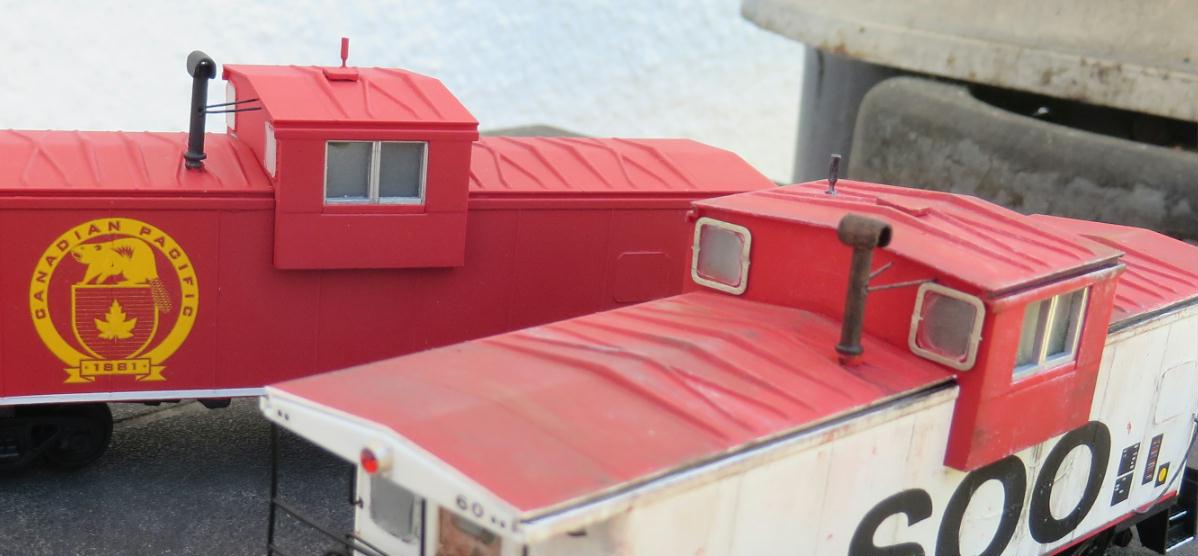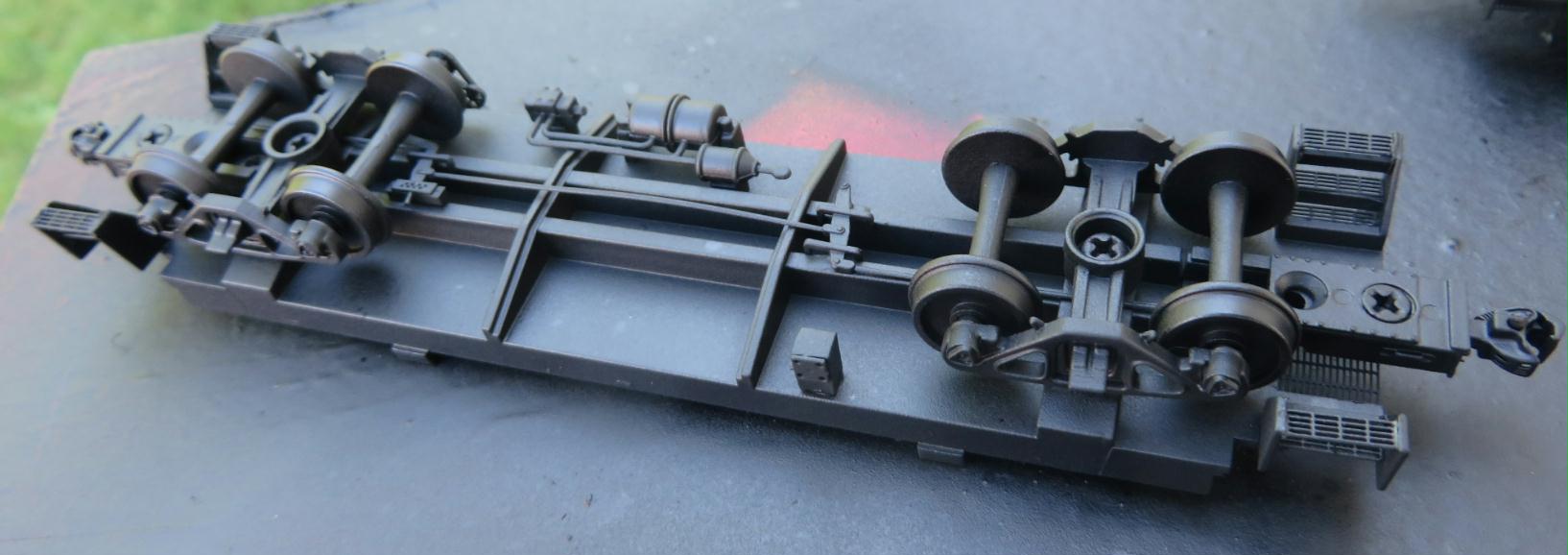Detailing & upgrading the new Walthers Mainline SOO caboose
Jun 28, 2019 16:20:10 GMT -8
Donnell Wells, valenciajim, and 12 more like this
Post by sd40dash2 on Jun 28, 2019 16:20:10 GMT -8
In May 2019, Walthers released an all-new model of the International Car Company wide vision caboose in their Mainline series. This budget-friendly line of cars is generally accurate for a least one prototype but minimally-detailed. In this case, the model represents cars from the 1973 SOO 56-145 number range. They featured X-panel roof, square cupola face windows and roller bearing caboose trucks among other smaller distinctive features.
The Walthers model accurately replicated most of these major features but I wanted a more finely-detailed model for my display case. I decided to build one model of a 1990s-era white SOO caboose #60 and one model of the unique 2018-era red Canadian Pacific repaint of #94.


The model was completely disassembled in preparation for the desired upgrades. Work was planned and executed in sub-assembly fashion. Shell work involved drilling for grab irons and railings along with a hole in the cupola roof for radio antenna installation. The paint was stripped from one shell using 99% alcohol (70% did not work) and it was repainted with True Line Trains "CP Bright Red" paint 010002. This matched the red on the cupola which I did not strip as I was unable to separate the window piece from the main part. A small styrene square was added to the cupola roof to simulate a caboose with its original strobe light removed but base left intact.

In comparing the model to prototype photos, the cupola side windows seemed too tall to my eyes. The bottom edge was filled with small pieces of styrene strip. The cupola face windows were nice but are not flush-fitting, so I cut squares of .005 acetate and glued them over top the existing windows, followed by adding custom .005 nickel silver window frame etches. The prototype windows appear fogged in many of the later photos of the prototype, so the windows were added before application of dullcote. The same process was followed for the body end windows while the side windows were plated over with .005 styrene squares to match prototype practice. After the United States Federal Railroad Administration mandated upgraded window glass for cabooses in the early-1980s, many railroads opted to cover over most of the windows instead of upgrading them with better glass. I also drilled a hole for a small piece of 3/64 styrene rod to replicate the fuel filler on one side. The interiors of both shells were hand painted with a repulsive shade of light-green paint to match prototype configuration. Smoke jacks were filed to remove flash and bracing was added after re-installation.

Underframe work involved cutting out the steps, end platforms and draft gear along with half-inch sections on both ends of the metal weight. Moloco draft gear parts #0413 were assembled and affixed with a screw that came through the floor and needed some weight removed for clearance. Plano #454 etched metal see-through platforms and steps were glued in place for an improved look over the original cast plastic pieces. I prefer Kadee scale-head whisker couplers #158 with trip pin removed. Brake gear details are Accurail #180 and a stove updraft vent was made from styrene and a custom face plate. A small piece of chain rounded out the underframe detailing. Trucks were detailed with AMB #226 axle generator parts and attached before the entire underframe was spray painted outside with Krylon flat black spray.





After all sub-assemblies were completed and independently weathered, both cabooses were re-assembled in preparation for final detailing. The white SOO 60 received replacement lettering from Herald King (C-100) and Microscale (87-1215) decal sets as I do not believe the Walthers font of the "SOO" lettering to be accurate. The Microscale decal set also included many of the smaller decals missing from the factory model, such as end marker lights U1B, COTS and ACI labels. SOO 94 was lettered with Highball Graphics custom number decals and Microscale set 87-1537 for the modern CPR beaver emblems and sill stripe. End railings include numerous small details such as chain, grab irons, air valve, FRA marker lights, air hoses and uncoupling levers. Here are photos of my finished models of SOO 60 and 94.




Acknowledgments: Thank you to several members of this forum for comments provided in the first half of 2019 while I researched this new model and its prototype. Their input can be seen in this thread:
All-new Walthers Mainline SOO wide vision caboose (2 photos)
The Walthers model accurately replicated most of these major features but I wanted a more finely-detailed model for my display case. I decided to build one model of a 1990s-era white SOO caboose #60 and one model of the unique 2018-era red Canadian Pacific repaint of #94.


The model was completely disassembled in preparation for the desired upgrades. Work was planned and executed in sub-assembly fashion. Shell work involved drilling for grab irons and railings along with a hole in the cupola roof for radio antenna installation. The paint was stripped from one shell using 99% alcohol (70% did not work) and it was repainted with True Line Trains "CP Bright Red" paint 010002. This matched the red on the cupola which I did not strip as I was unable to separate the window piece from the main part. A small styrene square was added to the cupola roof to simulate a caboose with its original strobe light removed but base left intact.

In comparing the model to prototype photos, the cupola side windows seemed too tall to my eyes. The bottom edge was filled with small pieces of styrene strip. The cupola face windows were nice but are not flush-fitting, so I cut squares of .005 acetate and glued them over top the existing windows, followed by adding custom .005 nickel silver window frame etches. The prototype windows appear fogged in many of the later photos of the prototype, so the windows were added before application of dullcote. The same process was followed for the body end windows while the side windows were plated over with .005 styrene squares to match prototype practice. After the United States Federal Railroad Administration mandated upgraded window glass for cabooses in the early-1980s, many railroads opted to cover over most of the windows instead of upgrading them with better glass. I also drilled a hole for a small piece of 3/64 styrene rod to replicate the fuel filler on one side. The interiors of both shells were hand painted with a repulsive shade of light-green paint to match prototype configuration. Smoke jacks were filed to remove flash and bracing was added after re-installation.

Underframe work involved cutting out the steps, end platforms and draft gear along with half-inch sections on both ends of the metal weight. Moloco draft gear parts #0413 were assembled and affixed with a screw that came through the floor and needed some weight removed for clearance. Plano #454 etched metal see-through platforms and steps were glued in place for an improved look over the original cast plastic pieces. I prefer Kadee scale-head whisker couplers #158 with trip pin removed. Brake gear details are Accurail #180 and a stove updraft vent was made from styrene and a custom face plate. A small piece of chain rounded out the underframe detailing. Trucks were detailed with AMB #226 axle generator parts and attached before the entire underframe was spray painted outside with Krylon flat black spray.





After all sub-assemblies were completed and independently weathered, both cabooses were re-assembled in preparation for final detailing. The white SOO 60 received replacement lettering from Herald King (C-100) and Microscale (87-1215) decal sets as I do not believe the Walthers font of the "SOO" lettering to be accurate. The Microscale decal set also included many of the smaller decals missing from the factory model, such as end marker lights U1B, COTS and ACI labels. SOO 94 was lettered with Highball Graphics custom number decals and Microscale set 87-1537 for the modern CPR beaver emblems and sill stripe. End railings include numerous small details such as chain, grab irons, air valve, FRA marker lights, air hoses and uncoupling levers. Here are photos of my finished models of SOO 60 and 94.




Acknowledgments: Thank you to several members of this forum for comments provided in the first half of 2019 while I researched this new model and its prototype. Their input can be seen in this thread:
All-new Walthers Mainline SOO wide vision caboose (2 photos)


